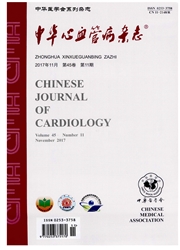

 中文摘要:
中文摘要:
目的探讨番茄红素对心肌细胞缺氧复氧损伤保护作用的机制。方法原代培养的C57BL/6乳鼠心肌细胞分为3组,即正常对照组(对照组)、缺氧复氧组(H/R组)和缺氧复氧加番茄红素组(L+H/R组)。观察各组乳鼠心肌细胞存活率和凋亡率,细胞色素C从线粒体向胞浆的释放情况以及半胱天冬酶-3(caspase-3)活性的变化,检测各组乳鼠心肌细胞内活性氧(reactive oxygenspecies,ROS)水平和细胞钙蛋白酶(calpain)活性。结果对照组、H/R组和L+H/R组乳鼠心肌细胞的存活率分别为(89.84±5.15)%、(63.59±5.11)%和(79.25±1.48)%,可见L+H/R组细胞存活率高于H/R组(P〈0.05)。对照组、H/R组和L+H/R组乳鼠心肌细胞凋亡率分别为(10.37±1.25)%、(32.03±4.79)%和(22.57±3.22)%,可见L+H/R组细胞凋亡率低于H/R组(P〈0.05)。对照组、H/R组和L+|L/R组caspase-3活性水平分别为(2.61±0.19)、(5.82±0.92)和(3.74±0.64)pNApmol/μg蛋白,可见L+H/R组显著低于H/R组(P〈0.05)。对照组、H/R组和L+H/R组乳鼠心肌细胞内ROS相对水平分别为100%、(239.79±27.27)%和(188.19±17.63)%,可见L+H/R组明显低于I-I/R组(P〈0.05)。对照组、H/R组和L+H/R组乳鼠心肌细胞内calpain活性分别为(272.33±300.46)%、(1156.00±212.02)%和(607.33±166.23)%,可见L+H/R组明显低于H/R组(P〈0.05)。结论番茄红素可能是通过抑制ROS介导的calpain活化,从而抑制心肌细胞凋亡,最终减轻了心肌细胞的缺氧复氧损伤。
 英文摘要:
英文摘要:
Objective To investigate the possible mechanism of lycopene on protecting against hypoxia/reoxygenation (H/R)-injury. Methods Primary cultured cardiomyocytes, isolated from neonatal mouse, were divided into three groups randomly: control group(C) ; H/R group(4 h H followed by 8 h R) ; lycopene ± H/R group( L ± H/R), in which the cardiomyocytes were pretreated with lycopene for 4 h before H/R. The survival of cardiomyocytes was counted. Apoptotic cells were detected by TUNEL assays. The release of cytochrome c from mitochondrial matrix into the cytosol, the activity of caspase-3, intracellular ROS levels and the activity of calpain were also determined in these groups respectively at the same time. Results The pretreatment of cardiomyocytes with lycopene significantly improved the survival of cardiomyocytes [ C : (89. 84 ± 5.15 ) %, H/R : ( 63.59 ± 5.11 ) %, L ± H/R : ( 79. 25 -± 1.48 ) %, P 〈 0. 05 ] and reduced the extent of apoptosis [ C : ( 10. 37 ± 1.25 ) %, I-I/R : ( 32. 03 ± 4.79 ) %, L ± H/R : (22. 57 ± 3.22 ) %, P 〈 0.05 ], significantly reduced caspase-3 activation [ C : ( 2. 61 ± 0. 19 ), H/R : (5.82±0.92),L ± H/R: (3.74 ±0.64) pNA pmol/μg protein, P 〈0.05]. To further study the mechanism underlying the benefits of lycopene, interactions between lyeopene and calpain activation were examined. Lyeopene pretreatment of cardiomyocytes suppressed the activation of calpain (C:272. 33 ± 300. 46, H/R: 1156.00 ± 212. 02, L ± H/R: 607.33 ± 166. 23, P 〈 0. 05 ) by reducing the H/R induced increased intracellular ROS levels [ C: 100%, H/R: (239.79 ± 27.27)%, L ± H/R: ( 188.19 ± 17.63 ) % ,P 〈 0.05 ]. Conclusion Lycopene may protect against hypoxia/reoxygenation-induced injury bypreventing calpain activation.
 同期刊论文项目
同期刊论文项目
 同项目期刊论文
同项目期刊论文
 期刊信息
期刊信息
